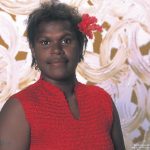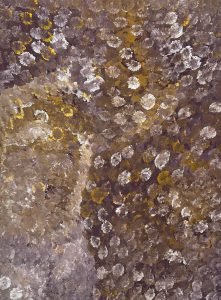Featured Artists
Featured Artist | Art has always been an important part of Aboriginal life as it reinforces the people to their land, their relationship to it and their culture. Indigenous Art is about storytelling and preserving the culture for future generations, telling the creation and Dreamtime stories and keeping the culture alive. Australian and Oceanic Art Gallery plays a role in promoting contemporary Indigenous Art, with our featured artists.
Featured Indigenous Artist - Rosella Namok

Featured Artist | Rosella Namok
Allow me to introduce Rosella, an incredibly important artist in our gallery, she is a renowned Australian Aboriginal artist known for her vibrant and captivating artwork. Rosella’s unique artistic style and innovative approach have captivated audiences worldwide She was born in 1979 and belongs to the Ku Ku Yalanji language group from the tropical rainforest region of Far North Queensland, Australia. Namok grew up in the remote community of Lockhart River.
Namok’s artwork is inspired by the natural beauty and cultural significance of her homeland. Her distinct artistic style is characterized by bold, expressive brush strokes and vibrant colors, reflecting the energy and vitality of her surroundings. She often depicts the landscapes, plants, animals, and the important Dreamtime stories of her ancestral heritage.
Namok’s paintings have received great acclaim both nationally and internationally. Her artwork has been exhibited in various galleries and museums, including the National Gallery of Australia and the Queensland Art Gallery. She is widely recognized for her contributions to contemporary Aboriginal art and for preserving and sharing her cultural heritage through her beautiful creations.
Namok’s artwork serves as a powerful medium for storytelling and cultural expression, blending traditional knowledge with modern artistic techniques. Through her paintings, she invites viewers to appreciate and understand the deep connection and relationship Aboriginal people have with their land, history, and spirituality.
Overall, Rosella Namok’s biography demonstrates not only her exceptional talent as an artist but also her dedication to portraying and preserving the richness of her Aboriginal heritage through her unique and captivating artwork.
Rosella Namok won the High Court Centenary Art Prize in 2003.
Art Gallery of South Australia
Featured Indigenous Artist - Naata Nungarrayi

Naata Nungarrayi is one of Australia’s most significant contemporary artists. Naata was born c.1932 at the rockhole site of Kumil, west of the Pollock Hills in Western Australia. She lived in Walungurru (Kintore) with her late sister Nancy Nungurrayi. Naata is from the Pintupi Language group.
Naata was born in the area of Pollock Hills, Western Australia. Naata and her family came to Papunya from the desert bush in 1962. When Walungurru (Kintore) was established as the main Pintupi settlement in early 1982, Naata moved there with Pintupi people from her camp and from the west camp at Papunya. Naata started painting in late 1994 at Kintore along with other women artists from the Haasts Bluff community and commenced painting for Papunya Tula artists in 1996.
In 1999 Naata, her late sister Nancy Nungurayi, (also a highly respected artist), and eight other women from Walumgurru, collaborated on a large canvas, which was subsequently exhibited at the Art Gallery of NSW in Sydney. Naatas depictions include the Marrapinti rock hole site.
In 2003 Naata Nungurrayi was honored with having one of her paintings chosen to appear on an Australia Post International stamp and was named among the Top 50 of Australia’s Most Collectable Artists by Australian Art Collector in 2004.
Naata passed away on 24 September 2021.
Link to Art Gallery NSW
Great Article in Financial Times “In praise of Australian Aboriginal Art – ‘the oldest surviving culture in the world’ Link to Article
Featured Indigenous Artist - Emily Kame Kngwarreye

Emily Kame Kngwarreye is one of Australia’s most significant contemporary artists. Emily was born at the beginning of the twentieth century and grew up in a remote desert area known as Utopia, 230 kilometres northeast of Alice Springs, distant from the art world that sought her work.
Although Emily began to paint late in her life she was a prolific artist who often worked at a pace that belied her advanced age. It is estimated that she produced over 3000 paintings in the course of her eight-year painting career — an average of one painting per day.
For virtually two-thirds of her life, she had only sporadic contact with the outside world. It was not until she was about 80 that she became, almost overnight, an artist of national and international standing.
Her remarkable work was inspired by her cultural life as an Anmatyerre elder, and her lifelong custodianship of the women’s Dreaming sites in her clan Country, Alhalkere.
It was in Alhalkere that the essence of her being resided, it was her Dreaming that was the source of the creative power, of her knowledge. So profound was her identification with Alhalkere that it infused her life and her belief system, and governed her kinship relations and connections with other people. Alhalkere was the source of her paintings — her genius loci. Even physically, Emily’s pierced nose bore homage to the ancestor Alhalkere, a pierced rock standing in the Country of the same name.
Alhalkere was the place and the law that she continually re-created in her art. Emily Kame Kngwarreye’s visions of Alhalkere are her personal cultural legacy to the world. Whenever Emily was asked to explain her paintings, regardless of whether the images were a shimmering veil of dots, a field of ‘dump dump’ dots, raw stripes seared across the surface or elegant black lines, her answer was always the same:
“Whole lot, that’s whole lot, Awelye (my Dreaming), Arlatyeye (pencil yam), Arkerrthe (mountain devil lizard), Ntange (grass seed), Tingu (Dreamtime pup), Ankerre (emu), Intekwe (a favourite food of emus, a small plant), Atnwerle (green bean), and Kame (yam seed). That’s what I paint, whole lot.”
The enactment of these strong cultural connections to her community and Country through kinship ties, ancestral history and law was an everyday practice that informed her art, making her life and art inseparable.
Link to National Museum of Australia
Great Article in Financial Times “In praise of Australian Aboriginal Art – ‘the oldest surviving culture in the world’ Link to Article
Featured Indigenous Artist - Yannima Tommy Watson

Featured Aboriginal Artist | Yannima Tommy Watson
Yannima Tommy Watson was a senior Pitjantjatara elder and lawman of the Karima skin group. He was born around 1935 in Anumarapiti, 75 kilometres west of Irrunytju, also known as Wingellina, in Western Australia, near the junction of its border with the Northern Territory and South Australia. His traditional names of Yannima and Pikarli relate to specific sites near Anumarapiti.
Early Life
From a young age, Tommy learned bush skills, travelling from water hole to water hole, hunting and gathering and living off the land. Tommy’s parents and uncle died when he was very young and he was adopted by his father’s first cousin Nicodemus Watson and adopted the surname Watson in addition to his Aboriginal birth name.
Nicodemus Watson became a strong father figure. Together they travelled widely, and Watson learned the traditional skills required to lead a nomadic existence in the desert, including the fashioning of tools and weapons from trees using burning coals, how and what to hunt, and how and where to find water. He learned to understand the spiritual and tribal law teachings of his ancestors.
Watson’s first contact with white Australians was at the Ernabella Mission in South Australia, which opened in 1940. After a short time at Ernabella, he returned to his community to be initiated. Tommy Watson’s upbringing is similar to that of many Indigenous people born around the same time, from that point forward living a traditional nomadic existence until his early teens and then working as a stockman and labourer.
Painting Career
Tommy Watson began painting in 2001 and was one of a handful of painters establishing the Irrunytju community art centre in 2001. His work, rich in the knowledge of the topographical landforms of his country and the spiritual law that underlies it has received critical acclaim, both within Australia and internationally. John MacDonald wrote in the Sydney Morning Herald that Watson “is a master of invention and arguably the outstanding painter of the Western Desert”, going on to compare his use of colour to Henri Matisse. He painted the stories of his mother’s and grandfather’s country using large vibrant colours and layers of coloured dots. Tommy has been associated with the “Colour Power’ movement that developed with the Indigenous art scene between 1984 and 2004.
Tommy Watson was one of eight Indigenous artists, alongside Paddy Bedford, John Mawurndjul, Ningura Napurrula, Lena Nyadbi, Michael Riley, Judy Watson and Gulumbu Yunupingu, who collaborated on a commission to provide works that decorate one of the Musée du quai Branly’s four buildings completed in 2006.
In 2014 the Art Series Hotel Group named Watson the first Indigenous artist to feature in the collection. Located in Adelaide, his namesake hotel The Watson features a collection of high-quality reproduction prints.
Watson himself stated that his art is an exploration of traditional Aboriginal culture, in which the land and spirituality are intertwined and communicated through stories passed on from generation to generation. He said, “I want to paint these stories so that others can learn and understand our culture and country,”
Featured Indigenous Artist - Linda Syddick Napaltjarri
Our Featured Aboriginal Artist this month is Linda Syddick Napaltjarri, a Pintupi and Pitjantjatjara speaking Indigenous woman from the Western desert region. She was part of the last generation of Pintupi people who grew up in a completely traditional nomadic life until she was eight when her family walked out of the desert to the Mission at Haast Bluff.
Linda’s father was killed by a revenge spearing when Linda was very young. Sometime later, her Mother married Shorty Lungkarta Tjungarrayi, a prominent artist who significantly influenced Linda Syddicks artwork along with her Uncles Uta Uta Tjangala and Nosepeg Tjupurrula. Linda married Musty Siddick and had two children, Ruby and Irene; she remarried after Musty’s death.
Linda Syddick took up painting in the early 1990s as part of the broader contemporary Indigenous Australian art movement. She first exhibited in a private gallery in Alice Springs. Her work is a fusion of traditional Aboriginal themes and motifs with Christian and Mission influences.
WINDMILL STORY
When they first travelled to the settlement at Mt Liebig, a Nangkari (witch doctor) travelled with them. On seeing a windmill, he took it to be an evil spirit and attacked it with his magic. Shorty Tjungarrayi, who had contact with the white settlers having worked with the army during the War, had seen a windmill and knew its purpose, persuaded the witchdoctor that it was not an evil spirit but brought water up from the ground.

































